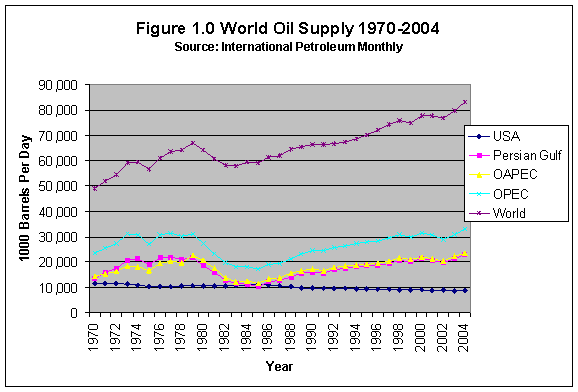When Edwin Drake in 1859 struck oil near Titusville, Pennsylvania, few people then would have worried about just how long petroleum would keep flowing out of the ground. Since the world oil production peaked in the 1970s, a growing number of people in the oil and gas industries have questioned how long the world hydrocarbon supplies will keep up with the ever-growing demand.
Concern over the future of the oil and gas supply emerges now stronger than ever because of the uncertainty of estimates of worldwide reserves. And the current situation reflects an increasing fear that existing reserves and productive crude oil capacity have become subject to potential geopolitical adversity.
With the constantly increasing demand fo petroleum products from emerging nations, world crude oil demand has been growing at an average rate of 2-3 per cent a year over the past five years. Demand growth is highest in the developing world, particularly in China and India, due to rapidly rising demand for transport, such as cars and trucks powered with internal combustion engines. China alone accounted for around 40 per cent of the global growth in oil demand in recent years. For economic and or political reasons, this high demand growth component did not exist in most of the developing world even a decade ago.
Advertisement
The economic prosperity of the oil and gas dependent industry in the 20th century was driven by cheap, oil-based energy. Exploration and new discoveries reached a peak in the early 1960s with simple and affordable technologies and 75 per cent of the current oil supply comes from fields that were discovered before 1973. Fossil fuels are non-renewable (at least for the time being); today demand and production both stand at about 70 million barrels of oil per day (Table 1). With a simple extrapolation into 2020, potential demand may well be 120 million barrels a day with production well below this. May be we won’t be “out of oil”; but the reality is when supply falls behind demand, prices will rise, as we are experiencing now.
The global crude oil reserves
Despite daily reports and publications on the global crude oil reserves a true estimation is not simple. Reserves are known sources of oil that are extractable given current technologies at current prices. The reserves estimates of international oil corporations are constantly revised as new oil fields are developed or new information on existing fields provides a basis for refinement or new technology improves the recovery factor.
It is important that reserves and production should not be confused. Using the price as a basis for economically recoverable reserves, some oil companies developed a price-reserves relationship that incorrectly led to increased estimates of oil reserves. There are many vested interests that define oil reserves to meet political or economic objectives including the multinational oil companies. Since OPEC production quotas are based partly on reserves, several countries report the highest reserve numbers possible. In the former Soviet Union, oil reserves often were exaggerated by the inclusion of in-place oil that was neither economically nor technically recoverable.
However of the 2 trillion barrels of reserves currently estimated, 6 per cent are in North America, 9 per cent in Central and Latin America, 2 per cent in Europe, 4 per cent in Asia Pacific, 7 per cent in Africa, 6 per cent in the Former Soviet Union. Today, 66 per cent of global oil reserves are in the hands of Middle Eastern countries: Saudi Arabia (25 per cent), Iraq (11 per cent), Iran (8 per cent), UAE (9 per cent), Kuwait (9 per cent), and Libya (2 per cent) (Institute for the Analysis of Global Security).
World oil supply
Assuming the world’s oil reserves estimates are reasonably accurate and the undiscovered world oil, the original recoverable oil endowment of the earth may have been around 3 trillion barrels. Almost one-third of this amount already has been produced and consumed. The remaining two-thirds of the world’s original oil in place could sustain world production at about its current yearly level of 25-30 billion barrels for perhaps 60 years. Keeping in mind that the remaining oil is distributed as follows; 79 per cent of it in the Eastern Hemisphere and 58 per cent controlled by OPEC (tables 1). It might make more sense if we look at the future of the oil industry on a country-by-country basis.
In any event it is unlikely that any oil producing country will be able to maintain its rate of oil production long-term. Note that several countries that appear to be unable to sustain current oil production for the next ten years (Australia, Canada, the United Kingdom, and Norway) are developed countries that export oil. The countries with the greatest long-term potential, and the potential to significantly increase shorter-term production, generally are grouped in the Persian Gulf area. It is to this region, that the rest of the world must turn for future major oil supplies.
Advertisement

World demand on oil
In the early 1970s, oil accounted for about one-half of total world primary energy demand. By 1995, oil’s contribution had declined to about 40 per cent (Washington Times, November 1, 2004).
Tables 1-3 indicate that the non-OPEC oil producing countries of the former Soviet Union (Russia, Azerbaijan, Kazakhstan, Turkmenistan, and Uzbekistan) and some of the Latin American countries (Colombia, Mexico, Brazil, Trinidad) have sufficient oil reserves and resources to increase oil production. That is if a variety of governmental, legal, social, and financial problems are solved and in addition very significant upstream oil investments are made.